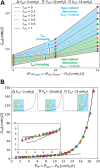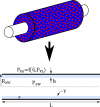Microscale to mesoscale analysis of parenchymal tethering: the effect of heterogeneous alveolar pressures on the pulmonary mechanics of compliant airways
- PMID: 30676866
- PMCID: PMC6589812
- DOI: 10.1152/japplphysiol.00178.2018
Microscale to mesoscale analysis of parenchymal tethering: the effect of heterogeneous alveolar pressures on the pulmonary mechanics of compliant airways
Abstract
In the healthy lung, bronchi are tethered open by the surrounding parenchyma; for a uniform distribution of these peribronchial structures, the solution is well known. An open question remains regarding the effect of a distributed set of collapsed alveoli, as can occur in disease. Here, we address this question by developing and analyzing microscale finite-element models of systems of heterogeneously inflated alveoli to determine the range and extent of parenchymal tethering effects on a neighboring collapsible airway. This analysis demonstrates that micromechanical stresses extend over a range of ∼5 airway radii, and this behavior is dictated primarily by the fraction, not distribution, of collapsed alveoli in that region. A mesoscale analysis of the microscale data identifies an effective shear modulus, Geff, that accurately characterizes the parenchymal support as a function of the average transpulmonary pressure of the surrounding alveoli. We demonstrate the use of this formulation by analyzing a simple model of a single collapsible airway surrounded by heterogeneously inflated alveoli (a "pig-in-a-blanket" model), which quantitatively demonstrates the increased parenchymal compliance and reduction in airway caliber that occurs with decreased parenchymal support from hypoinflated obstructed alveoli. This study provides a building block from which models of an entire lung can be developed in a computationally tenable manner that would simulate heterogeneous pulmonary mechanical interdependence. Such multiscale models could provide fundamental insight toward the development of protective ventilation strategies to reduce the incidence or severity of ventilator-induced lung injury. NEW & NOTEWORTHY A destabilized lung leads to airway and alveolar collapse that can result in catastrophic pulmonary failure. This study elucidates the micromechanical effects of alveolar collapse and determines its range of influence on neighboring collapsible airways. A mesoscale analysis reveals a master relationship that can that can be used in a computationally efficient manner to quantitatively model alveolar mechanical heterogeneity that exists in acute respiratory distress syndrome (ARDS), which predisposes the lung to volutrauma and/or atelectrauma. This analysis may lead to computationally tenable simulations of heterogeneous organ-level mechanical interactions that can illuminate novel protective ventilation strategies to reduce ventilator-induced lung injury.
Keywords: acute respiratory distress syndrome; mechanical ventilation; parenchymal tethering; reduced-dimension model; shear modulus.
Conflict of interest statement
No conflicts of interest, financial or otherwise, are declared by the authors.
Figures










References
-
- Balay S, Abhyankar S, Adams M, Brune P, Buschelman K, Dalcin L, Gropp W, Smith B, Karpeyev D, Kaushik D. Petsc Users Manual Revision 3.7. Argonne, IL: Argonne National Laboratory, 2016.
-
- Budiansky B, Kimmel E. Elastic moduli of lungs. J Appl Mech 54: 351–358, 1987. doi:10.1115/1.3173019. - DOI
-
- Falgout RD, Yang UM. Hypre: a library of high performance preconditioners. In: Computational Science – ICCS 2002 Part III, edited by Sloot PMA, Tan CJK, Dongarra JJ, and Hoekstra AG. International Conference on Computational Science Springer-Verlag, 2002, p. 632–641.
Publication types
MeSH terms
Grants and funding
LinkOut - more resources
Full Text Sources

